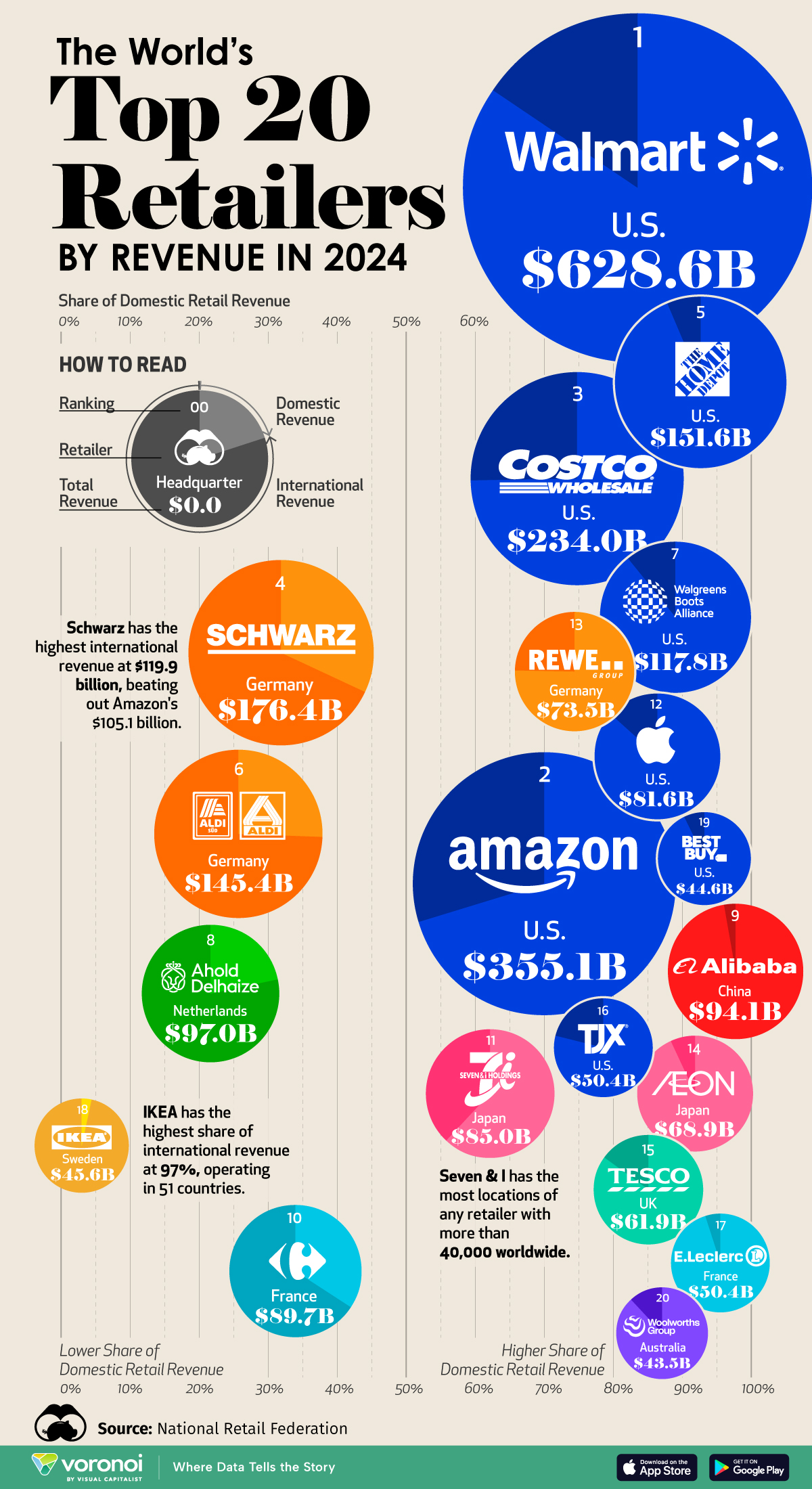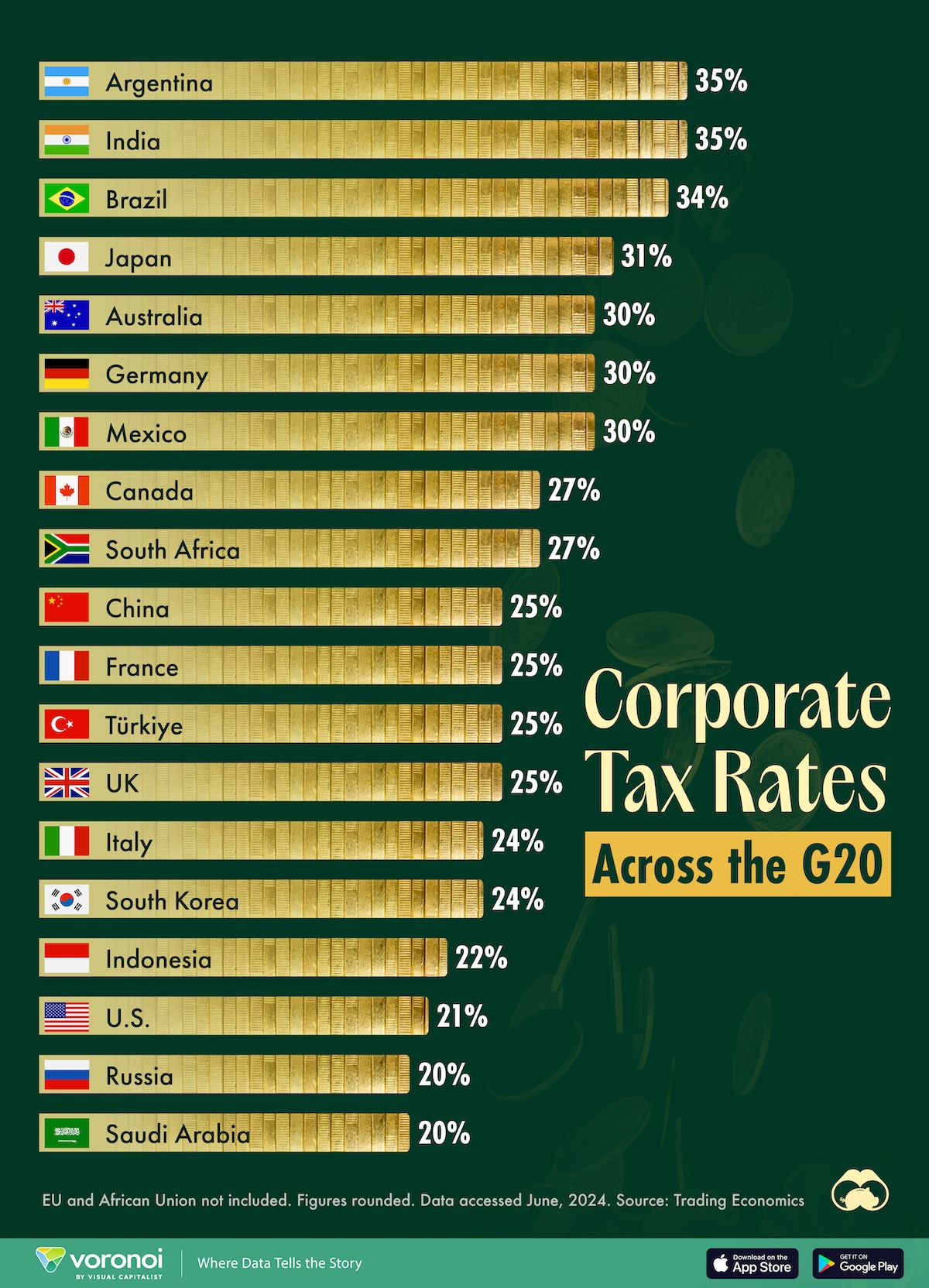Markets
Ranked: The 20 Top Retailers Worldwide, by Revenue
![]() See this visualization first on the Voronoi app.
See this visualization first on the Voronoi app.
The Top Retailers Worldwide, by Revenue
This was originally posted on our Voronoi app. Download the app for free on iOS or Android and discover incredible data-driven charts from a variety of trusted sources.
The global retail landscape is constantly evolving, driven by shifting consumer habits and the growing dominance of online sales.
Despite the rise of e-commerce, many of the top retailers worldwide generate the bulk of their sales in physical stores. However, as customers prioritize convenience and a wider selection of goods, e-commerce giants are capturing an increasing share of the retail market.
This graphic shows the world’s leading retailers by revenue, based on data from the National Retail Federation.
The Methodology
To be included in the rankings, companies must engage in a goods-for-consumer resale business accessible to the public. Additionally, they must and have direct selling operations in a minimum of three companies. The rankings include both public and private companies, based on the most recent 52-week period ending between January and March 2024. All revenue figures were converted to U.S. dollars.
Ranked: The Top 20 Global Retailers
Below, we show the world’s leading retail giants by revenue:
| Ranking | Retailer | Total Revenues | Share of Domestic Retail Revenue | Headquarters |
|---|---|---|---|---|
| 1 | Walmart | $628.6B | 84.7% | 🇺🇸 U.S. |
| 2 | Amazon.com | $355.1B | 70.4% | 🇺🇸 U.S. |
| 3 | Costco | $234.0B | 75.0% | 🇺🇸 U.S. |
| 4 | Schwarz Group | $176.4B | 32.0% | 🇩🇪 Germany |
| 5 | The Home Depot | $151.6B | 93.7% | 🇺🇸 U.S. |
| 6 | Aldi | $145.4B | 25.8% | 🇩🇪 Germany |
| 7 | Walgreens Boots Alliance | $117.8B | 89.3% | 🇺🇸 U.S. |
| 8 | Ahold Delhaize | $97.0B | 21.8% | 🇳🇱 Netherlands |
| 9 | Alibaba | $94.1B | 97.3% | 🇨🇳 China |
| 10 | Carrefour | $89.7B | 34.3% | 🇫🇷 France |
| 11 | Seven & I | $85.0B | 62.1% | 🇯🇵 Japan |
| 12 | Apple | $81.6B | 86.9% | 🇺🇸 U.S. |
| 13 | Rewe | $73.5B | 75.5% | 🇩🇪 Germany |
| 14 | Aeon | $68.9B | 93.3% | 🇯🇵 Japan |
| 15 | Tesco | $61.9B | 85.1% | 🇬🇧 UK |
| 16 | TJX | $50.4B | 78.9% | 🇺🇸 U.S. |
| 17 | Leclerc | $50.4B | 95.0% | 🇫🇷 France |
| 18 | IKEA | $45.6B | 3.4% | 🇸🇪 Sweden |
| 19 | Best Buy | $44.6B | 92.8% | 🇺🇸 U.S. |
| 20 | Woolworths Limited (Aus) | $43.5B | 88.2% | 🇦🇺 Australia |
As the largest retailer by sales globally, Walmart raked in $628.6 billion dollars in revenue, with 84.7% of its revenue being domestic.
Today, about 90% of Americans are located within 10 miles of a Walmart store, attracting 200 million visitors each month. To gain a greater edge in the market, Walmart is expanding its advertising business, launching a premium product line, and growing its digital sales channels.
Additionally, it is opening 150 stores in the U.S over the next five years, its largest expansion in almost a decade.
With $355.1 billion in sales, e-commerce titan Amazon ranks in second. In 2024, the company is projected to account for 40.4% of U.S. e-commerce sales. Along with this, Amazon operates physical stores through its Whole Foods subsidiary, Amazon Go, and Amazon Fresh storefronts, yet these make up a fraction of its total retail sales.
As Asia’s largest retailer, Alibaba, falls in ninth place, driven by its Taobao and Tmall online marketplace platforms. While domestic sales comprise the majority of its retail revenues, the company is increasingly focusing on its overseas business given sluggish domestic consumption in China. Notably, retail sales jumped 44% year-over-year across its international retail operations as of the quarter ending in December 2023.
Despite regulatory crackdowns in recent years, it is the seventh-largest company by market cap in the country as of March 2024 across publicly-traded firms.
Retailers With the Highest International Revenues
Across the top 20 retailers by revenue, Germany’s Schwarz Group generated the most sales from international revenues, at $119.9 billion.
As Europe’s largest retailer, Schwarz Group operates in 30 countries worldwide, with overseas operations accounting for 68% of all revenues. Overall, the family-owned multinational serves 7.2 billion customers annually across 14,112 stores.
Swedish furniture giant, IKEA, generates 96.6% of its retail revenues from international stores, the highest share overall. Given that Sweden is known for its steep corporate tax rates, the company strategically expanded its operations worldwide, while retaining the core essence of its brand.
In recent years, the company has experimented with creating more compact stores in urban centers, unlike its traditional suburban warehouses. Through this strategy, its aiming to drive revenues from higher traffic volume in malls as opposed to customers who travel to stores less frequently, but buy more products.
Beyond these retail giants, a number of European chains generate more than half of their revenues from international operations, including Germany’s discount grocery company, Aldi, and France’s Carrefour.
Markets
Which Countries Have the Highest Corporate Tax Rates in the G20?
Interestingly, BRICS members cover the spectrum of corporate tax rates in the G20 from highest (India, Brazil) to lowest (Russia).
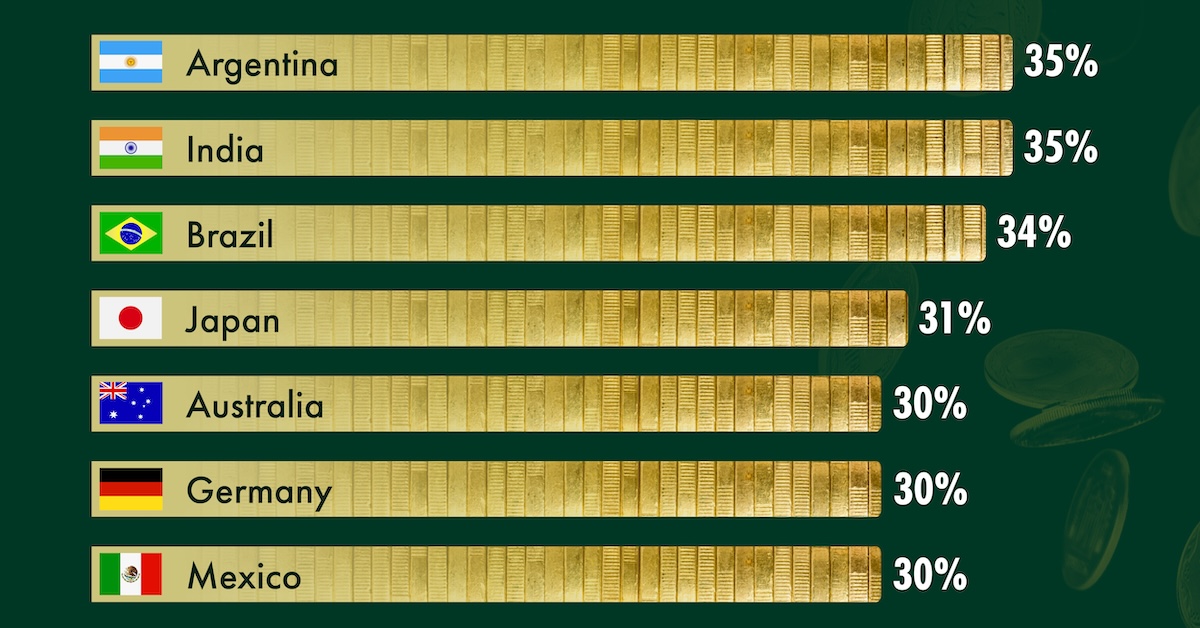
Which Countries Have the Highest Corporate Tax Rates in G20?
This was originally posted on our Voronoi app. Download the app for free on iOS or Android and discover incredible data-driven charts from a variety of trusted sources.
In the wake of the 1999 Asian financial crisis, government representatives from the 20 largest economies in the world decided to informally gather to coordinate policy on trade. Thus began the G20.
Together the bloc accounts for more than 85% of the world economy and has been credited with unified policy action in response to world events.
However, despite this shared affiliation, this group is still made of fundamentally different economies with varied policies towards their business entities.
For a quick overview, we visualize and rank the G20 countries by their headline corporate tax rates. Data is sourced from Trading Economics, accessed June 2024. Data for the EU and the African Union (both G20 members) has not been included.
Ranked: G20 Members by Their Corporate Tax Rates
Argentina and India have the highest corporate income tax rates, at 35% in the G20.
However, both countries have a progressive ladder for taxation, so this headline number may only apply to a smaller subset of firms. For foreign companies with a “permanent entity” in India, the rate climbs past 40%.
| Rank | G20 Member | Corporate Tax Rate |
|---|---|---|
| 1 | 🇦🇷 Argentina | 35% |
| 2 | 🇮🇳 India | 35% |
| 3 | 🇧🇷 Brazil | 34% |
| 4 | 🇯🇵 Japan | 31% |
| 5 | 🇦🇺 Australia | 30% |
| 6 | 🇩🇪 Germany | 30% |
| 7 | 🇲🇽 Mexico | 30% |
| 8 | 🇨🇦 Canada | 27% |
| 9 | 🇿🇦 South Africa | 27% |
| 10 | 🇨🇳 China | 25% |
| 11 | 🇫🇷 France | 25% |
| 12 | 🇹🇷 Türkiye | 25% |
| 13 | 🇬🇧 UK | 25% |
| 14 | 🇮🇹 Italy | 24% |
| 15 | 🇰🇷 South Korea | 24% |
| 16 | 🇮🇩 Indonesia | 22% |
| 17 | 🇺🇸 U.S. | 21% |
| 18 | 🇷🇺 Russia | 20% |
| 19 | 🇸🇦 Saudi Arabia | 20% |
Note: EU and African Union not included. Figures rounded. Data accessed June 2024.
Interestingly, BRICS countries cover the spectrum of corporate tax rates. Starting from the highest (India, Brazil) to middle of the pack (South Africa, China) to lowest (Russia).
On the other hand, most of the G7 cluster in the mid-ranges (24–30%), with Japan the highest outlier (31%) and the U.S. the lowest exception (21%).
In fact, after Saudi Arabia and Russia (20%), the U.S. has the third-lowest corporate tax rate of all G20 economies.
This wasn’t always the case. The 2018 “Trump Tax” law was the largest overhaul of the tax code in three decades, part of which reduced the corporate tax rate from 35% to 21%.
-

 Misc1 week ago
Misc1 week agoWhere Unemployment Benefits are the Highest, in OECD Countries
-
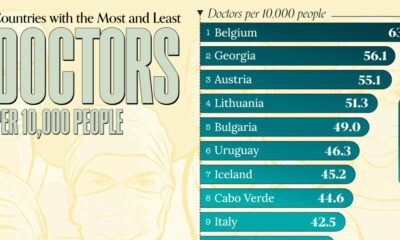
 Maps1 week ago
Maps1 week agoMapped: Highest and Lowest Doctor Density Around the World
-

 Money1 week ago
Money1 week agoRanked: The World’s Top 10 Billionaires in 2024
-

 Markets1 week ago
Markets1 week agoAll of the World’s Trillion-Dollar Companies in One Chart
-

 Markets1 week ago
Markets1 week agoThe Growth of $100 Invested in Jim Simons’ Medallion Fund
-

 Stocks1 week ago
Stocks1 week agoCharted: Four Decades of U.S. Tech IPOs
-
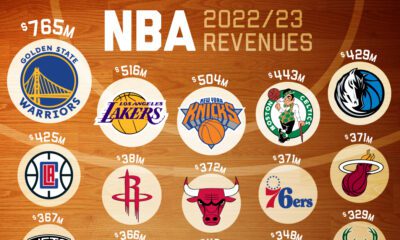
 Markets1 week ago
Markets1 week agoRanked: Which NBA Team Takes Home the Most Revenue?
-

 Markets1 week ago
Markets1 week agoCharted: Stock Buybacks by the Magnificent Seven

